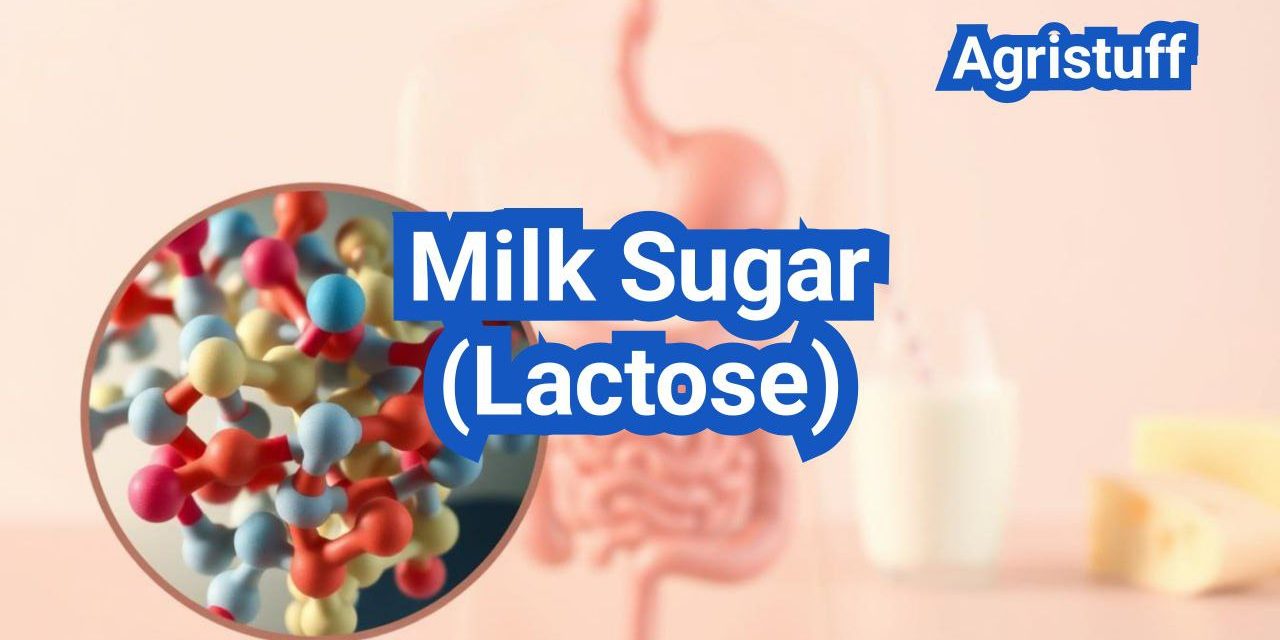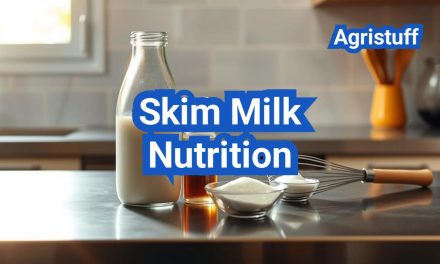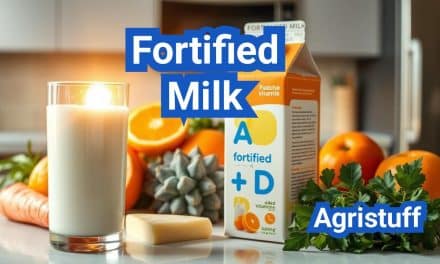This article does not contain medical advice
Lactose, commonly known as milk sugar, is a naturally occurring sugar found in dairy products. The digestion of lactose involves the enzyme lactase, which breaks down lactose into easily absorbed sugars.
Individuals with lactose intolerance have a deficiency of lactase, leading to uncomfortable symptoms after consuming lactose-containing products. However, research from the NCBI Bookshelf suggests that people who are lactose intolerant can still consume small amounts of lactose-containing products.
Understanding lactose, its digestion, and intolerance is crucial for managing dietary choices. This article will explore the chemical structure of lactose, its nutritional role, and low-lactose options for those with intolerance.
Key Takeaways
- Lactose is a naturally occurring sugar in dairy products.
- Lactase enzyme is crucial for lactose digestion.
- Lactose intolerance occurs due to lactase deficiency.
- Small amounts of lactose can be tolerated by individuals with lactose intolerance.
- Low-lactose options are available for those with intolerance.
What Is Milk Sugar (Lactose)?
The term ‘milk sugar’ refers to lactose, a disaccharide composed of glucose and galactose molecules. This carbohydrate is found naturally in milk and other dairy products, playing a vital role in their nutritional content.
The Chemical Structure of Lactose
Lactose is a disaccharide formed by the condensation of glucose and galactose molecules. This unique bonding gives lactose its distinct properties and functions within the human diet. The chemical structure of lactose is crucial for understanding its digestion and metabolism.
“Lactose is an important energy source for infants and young mammals,” as noted in nutritional studies. Its chemical composition allows it to be broken down into simpler sugars during digestion.
Natural Occurrence in Dairy Products
Lactose is naturally occurring in various dairy products, with different types of milk containing varying levels. For instance, cow’s milk contains around 4.8% lactose, while human breast milk has a higher concentration, typically around 7%. The lactose content can vary significantly across different dairy products and species.
- Cow’s milk: approximately 4.8% lactose
- Human breast milk: around 7% lactose
- Goat’s milk: similar to cow’s milk, around 4.8% lactose
Lactose vs. Other Types of Sugars
Unlike other types of sugars, lactose is specifically found in milk and dairy products. Its digestion requires the enzyme lactase, which is produced in the small intestine. Understanding the differences between lactose and other sugars is essential for managing lactose intolerance and making informed dietary choices.
Lactose is distinct from other sugars like sucrose or fructose, which are commonly found in various foods. The body’s ability to digest lactose depends on the presence of lactase, making it a unique carbohydrate in human nutrition.
The Nutritional Role of Lactose in Diet

As a primary carbohydrate in milk, lactose is crucial for the growth and development of infants, serving as a vital source of energy. Lactose supports various physiological processes, making it an essential nutrient in early life stages.
Nutritional Benefits of Lactose
Lactose provides several nutritional benefits, particularly for infants and young children. It is a readily available source of energy, supporting the high energy demands of growth and development. Additionally, lactose promotes the absorption of minerals such as calcium and phosphorus, which are crucial for bone development.
Lactose also plays a role in the development of the gut. It serves as a prebiotic, feeding beneficial bacteria in the gut, thereby supporting a healthy gut microbiome. This prebiotic effect contributes to the overall immune system development and function.
Lactose in Human Development
Lactose is particularly important in infancy, where it is the primary source of carbohydrate in breast milk. The high lactose content in breast milk supports the rapid growth and development that occurs during this period. As children grow, their diet expands to include other sources of lactose, such as dairy products.
The role of lactose extends beyond infancy. It continues to contribute to nutrition throughout childhood and into adulthood, although the ability to digest lactose may decrease with age in some populations.
Comparing Lactose to Added Sugars
Unlike added sugars, which are often devoid of nutritional value, lactose is a naturally occurring sugar that provides significant nutritional benefits. Added sugars, commonly found in processed foods, can lead to a rapid increase in calorie intake without providing the same level of nutritional value as lactose.
| Nutritional Aspect | Lactose | Added Sugars |
|---|---|---|
| Natural Occurrence | Found in milk and dairy products | Commonly added to processed foods |
| Nutritional Value | Provides energy, supports mineral absorption | Primarily empty calories |
| Impact on Health | Supports gut health, bone development | Associated with increased risk of obesity, diabetes |
In conclusion, lactose plays a vital role in human nutrition, particularly in early life stages. Understanding its nutritional benefits and comparing it to added sugars highlights the importance of naturally occurring sugars in a healthy diet.
Measuring Milk Sugar Content in Different Products
Lactose content varies significantly across different dairy products, making it essential to understand these differences for those with lactose intolerance. The lactose levels in milk can impact digestive comfort, and knowing these levels can help individuals manage their condition more effectively.
Cow’s Milk Lactose Levels
Cow’s milk is one of the most commonly consumed dairy products worldwide. It typically contains around 4-5% lactose. This level can vary slightly depending on the breed of cow and the processing method. For instance, some studies suggest that the lactose content in milk from certain breeds like the Holstein can be slightly higher than in others.
Human Breast Milk Sugar Content
Human breast milk contains a higher lactose concentration compared to cow’s milk, with levels around 7%. This high lactose content is crucial for the development of infants, providing them with the necessary energy. The composition of breast milk is tailored to meet the nutritional needs of newborns, and its lactose content plays a significant role in their growth and development.
Goat, Sheep, and Other Animal Milks
Goat’s milk and sheep’s milk are other dairy alternatives that contain lactose, though their lactose levels can differ from cow’s milk. Generally, goat’s milk contains slightly less lactose than cow’s milk, while sheep’s milk has a higher lactose content. Other animal milks, such as buffalo milk, also contain lactose but at varying levels.
Sugar Content in Plant-Based Alternatives
Plant-based milk alternatives, such as almond milk, soy milk, and oat milk, are naturally lactose-free, making them a popular choice for individuals with lactose intolerance. However, it’s essential to check the labels, as some brands may add sugars or other ingredients that could affect their suitability for those managing lactose intolerance.
As stated by a nutrition expert, “Choosing the right milk alternative depends on understanding its nutritional content, including its sugar levels. For those with lactose intolerance, being informed is key to managing their condition effectively.”
How Your Body Processes Lactose

Understanding how the body processes lactose requires a look into the lactase enzyme’s function. Lactose, a sugar found in milk and other dairy products, is an essential nutrient for many individuals, particularly during infancy and early childhood.
The Lactase Enzyme: Function and Production
The lactase enzyme is crucial for breaking down lactose into glucose and galactose, two simpler sugars that the body can absorb and utilize for energy. This enzyme is produced in the small intestine, where most of our nutrient absorption takes place.
Lactase production is highest during infancy, allowing babies to digest their mother’s milk easily. As people age, the production of lactase can decrease significantly, leading to difficulties in digesting lactose.
The Digestive Process of Lactose
When lactose is consumed, it enters the digestive system, where it is broken down by the lactase enzyme into glucose and galactose. These simpler sugars are then absorbed into the bloodstream, where they can be used by the body for various functions, including energy production.
The efficiency of lactose digestion depends on several factors, including the amount of lactase enzyme produced and the presence of other nutrients that may influence lactose absorption.
| Stage | Description | Key Processes |
|---|---|---|
| Ingestion | Lactose is consumed through dairy products. | Lactose enters the digestive system. |
| Digestion | Lactose is broken down by lactase enzyme. | Conversion into glucose and galactose. |
| Absorption | Glucose and galactose are absorbed into the bloodstream. | Utilization by the body for energy. |
Age-Related Changes in Lactose Digestion
As individuals age, their ability to digest lactose can change due to variations in lactase production. Many people experience a decline in lactase production after weaning, which can lead to lactose intolerance in some populations.
Age-related changes in lactose digestion highlight the importance of understanding individual tolerance to lactose. Some populations maintain high levels of lactase production into adulthood, while others may experience a significant decrease.
Understanding Lactose Malabsorption
Lactose malabsorption occurs when the small intestine does not produce enough lactase, the enzyme responsible for breaking down lactose. This condition can lead to uncomfortable symptoms after consuming lactose-containing products.
Primary Lactose Malabsorption
Primary lactose malabsorption is the most common form, resulting from a natural decline in lactase production as people age. It is a normal part of development for many individuals, particularly those of non-European descent.
Secondary Lactose Malabsorption
Secondary lactose malabsorption occurs when an injury or disease damages the small intestine, leading to a decrease in lactase production. Conditions such as celiac disease, Crohn’s disease, and gastroenteritis can cause this type of malabsorption.
Congenital Lactase Deficiency
Congenital lactase deficiency is a rare genetic disorder characterized by a complete lack of lactase production from birth. This condition requires strict dietary management to ensure proper nutrition.
The following table summarizes the key differences between the types of lactose malabsorption:
| Type | Cause | Characteristics |
|---|---|---|
| Primary | Natural decline in lactase with age | Most common form, varies by ethnicity |
| Secondary | Injury or disease to the small intestine | Caused by conditions like celiac disease or gastroenteritis |
| Congenital | Genetic disorder | Rare, complete lack of lactase from birth |
Understanding the specific cause of lactose malabsorption is crucial for managing its symptoms and improving quality of life. By recognizing the differences between primary, secondary, and congenital lactose malabsorption, individuals can make informed dietary choices.
Identifying Lactose Intolerance Symptoms
Recognizing the symptoms of lactose intolerance is crucial for effective management. Lactose intolerance occurs when the body is unable to digest lactose, a sugar found in milk and other dairy products, due to a deficiency of the enzyme lactase.
Common Digestive Symptoms
The most common symptoms of lactose intolerance are related to digestion. These include:
- Bloating and gas
- Diarrhea
- Stomach cramps
- Nausea
These symptoms occur because undigested lactose is fermented by bacteria in the colon, producing gas and causing discomfort.
Less Common Symptoms
While less common, some individuals with lactose intolerance may experience symptoms that are not directly related to digestion, such as:
- Headaches
- Fatigue
- Muscle cramps
The exact mechanisms behind these symptoms are not fully understood but may be related to the body’s response to undigested lactose.
Symptom Severity and Lactose Threshold
The severity of lactose intolerance symptoms can vary significantly among individuals, depending on their lactose threshold—the amount of lactose they can consume without experiencing symptoms. Understanding one’s lactose threshold is key to managing the condition effectively.
| Lactose Threshold | Common Symptoms | Symptom Severity |
|---|---|---|
| Low | Bloating, gas, diarrhea | Severe |
| Moderate | Stomach cramps, nausea | Moderate |
| High | Minimal or none | Mild |
By identifying and understanding lactose intolerance symptoms, individuals can take the first step towards managing their condition and improving their quality of life.
How to Get Diagnosed for Lactose Intolerance
If you’re experiencing symptoms of lactose intolerance, getting diagnosed is crucial for managing your condition effectively. Diagnosing lactose intolerance involves several tests that help determine your body’s ability to digest lactose.
Hydrogen Breath Test Procedure
The hydrogen breath test is a widely used method for diagnosing lactose intolerance. This test measures the amount of hydrogen in your breath after consuming a lactose-containing drink. If you’re lactose intolerant, the undigested lactose is fermented by bacteria in the colon, producing hydrogen, which is then absorbed into the bloodstream and exhaled through the breath.
Here’s how the test is conducted:
- You will be asked to drink a liquid containing lactose.
- Your breath will be collected at regular intervals to measure the hydrogen levels.
- The test typically takes a few hours to complete.
Lactose Tolerance Test
The lactose tolerance test measures your body’s ability to digest lactose by assessing your blood glucose levels after consuming a lactose-containing drink. If your body can digest lactose properly, your blood glucose levels will rise.
The procedure involves:
- Consuming a lactose-containing beverage.
- Having your blood glucose levels measured at intervals.
- Comparing the results to determine how well your body digests lactose.
Stool Acidity Test
The stool acidity test is often used in infants and young children to diagnose lactose intolerance. It measures the acidity of the stool, as undigested lactose can lead to the production of lactic acid and other acidic compounds.
Genetic Testing for Lactase Persistence
Genetic testing can determine whether you have a genetic predisposition to lactose intolerance by analyzing the genes responsible for lactase production. This test can identify lactase non-persistence, indicating a likelihood of lactose intolerance.
| Diagnostic Test | Description | Population |
|---|---|---|
| Hydrogen Breath Test | Measures hydrogen in breath after lactose consumption | Adults and Children |
| Lactose Tolerance Test | Assesses blood glucose levels after lactose consumption | Adults and Children |
| Stool Acidity Test | Measures acidity of stool due to undigested lactose | Infants and Young Children |
| Genetic Testing | Analyzes genes for lactase production | All Ages |
Understanding the diagnostic process is crucial for developing an effective management plan for lactose intolerance. By identifying the most appropriate diagnostic test, individuals can better manage their symptoms and improve their quality of life.
Differentiating Between Lactose Intolerance and Milk Allergy

Differentiating between lactose intolerance and milk allergy is essential for effective management and relief from symptoms. While both conditions can cause discomfort after consuming dairy products, they have distinct causes and implications for health.
Key Differences in Symptoms and Mechanisms
Lactose intolerance is a non-allergic condition characterized by the inability to digest lactose due to insufficient production of the lactase enzyme. On the other hand, a milk allergy is an immune-mediated reaction to one of the proteins in milk (casein or whey). The symptoms can overlap, but the body’s response and the severity can vary significantly.
The symptoms of lactose intolerance are primarily gastrointestinal, including bloating, gas, and diarrhea. In contrast, a milk allergy can cause a range of symptoms from mild hives to life-threatening anaphylaxis. Understanding these differences is crucial for appropriate diagnosis and treatment.
Diagnostic Approaches
Diagnosing lactose intolerance typically involves tests such as the hydrogen breath test or lactose tolerance test. The hydrogen breath test measures the amount of hydrogen in the breath, which is produced when undigested lactose is fermented by bacteria in the colon. The lactose tolerance test assesses the body’s ability to digest lactose by measuring blood glucose levels after consuming a lactose-containing beverage.
In contrast, diagnosing a milk allergy may involve skin prick tests or blood tests to measure the immune system’s response to milk proteins. These tests can help identify the specific allergen causing the reaction.
| Diagnostic Test | Lactose Intolerance | Milk Allergy |
|---|---|---|
| Hydrogen Breath Test | Used | Not Used |
| Lactose Tolerance Test | Used | Not Used |
| Skin Prick Test | Not Used | Used |
| Blood Test | Not Used | Used |
Treatment Differences
Treatment for lactose intolerance usually involves dietary adjustments, such as reducing lactose intake or using lactase supplements. Individuals with lactose intolerance can often tolerate small amounts of lactose, and the condition is generally not life-threatening.
For milk allergy, treatment often involves avoiding milk and milk products entirely. In severe cases, individuals may need to carry an EpiPen to treat accidental exposures that could lead to anaphylaxis.
Understanding the differences between lactose intolerance and milk allergy is crucial for managing symptoms effectively and improving quality of life.
Creating a Lactose-Friendly Diet Plan
Creating a diet plan that accommodates lactose intolerance can significantly improve quality of life. Individuals with lactose intolerance need to manage their lactose intake carefully to avoid uncomfortable symptoms.
Determining Your Personal Lactose Threshold
Understanding your personal lactose threshold is crucial for developing a tailored diet plan. This involves identifying the maximum amount of lactose you can consume without experiencing symptoms.
To determine your lactose threshold, start by eliminating lactose-containing products from your diet for a few weeks. Then, gradually reintroduce small amounts of lactose to gauge your tolerance.
Gradual Reintroduction Techniques
Gradual reintroduction of lactose-containing foods is a key strategy for managing lactose intolerance. Begin with small portions and monitor your body’s reaction.
- Start with lactose-containing foods that are naturally low in lactose, such as hard cheeses or yogurt.
- Gradually increase the portion size over time, if tolerated.
- Keep a food diary to track your intake and any symptoms.
Reading Food Labels for Hidden Lactose
Being able to read food labels effectively is vital for avoiding hidden sources of lactose. Many processed foods contain lactose, so it’s essential to check the ingredient list.
Look out for ingredients like milk, whey, curds, and lactose. Some products may be labeled as “lactose-free” or “dairy-free,” making it easier to identify safe options.
Maintaining Balanced Nutrition Without Dairy
Maintaining balanced nutrition without dairy products requires careful planning. Ensure you’re getting enough calcium, vitamin D, and other essential nutrients from alternative sources.
| Nutrient | Dairy Source | Non-Dairy Alternative |
|---|---|---|
| Calcium | Milk | Fortified plant milk |
| Vitamin D | Fortified dairy | Sunlight exposure, supplements |
By incorporating these strategies into your diet plan, you can effectively manage lactose intolerance and maintain overall nutritional balance.
Choosing Low-Lactose Dairy Options

With the rise of lactose intolerance awareness, consumers are now seeking out low-lactose dairy alternatives that are easier to digest. This shift has led to a variety of products that cater to individuals with lactose intolerance, allowing them to enjoy dairy without the discomfort.
Lactose-Free Milk Products
Lactose-free milk products are an excellent option for those with lactose intolerance. These products have had the lactase enzyme added to break down the lactose, making them easily digestible. Lactose-free milk is available in various forms, including cow’s milk, almond milk, and soy milk, providing a range of choices for consumers.
Naturally Lower Lactose Cheeses
Certain types of cheese are naturally lower in lactose due to the fermentation process involved in their production. Cheeses like cheddar, Swiss, and parmesan are good examples. The bacteria used in fermenting these cheeses break down much of the lactose, resulting in a lower lactose content.
Yogurt and Fermented Dairy
Yogurt and other fermented dairy products are another category of low-lactose dairy options. The live cultures in yogurt, such as Lactobacillus bulgaricus and Streptococcus thermophilus, help digest lactose, making yogurt more tolerable for those with lactose intolerance.
Ultrafiltered Milk Products
Ultrafiltered milk products have gained popularity for their reduced lactose content and higher protein levels. The ultrafiltration process removes some of the lactose, making these products a good choice for those looking to minimize their lactose intake.
| Dairy Product | Lactose Content | Notes |
|---|---|---|
| Lactose-Free Milk | Zero to Low | Lactase enzyme added |
| Cheddar Cheese | Low | Fermented, contains live cultures |
| Yogurt | Low to Moderate | Contains live cultures that aid digestion |
| Ultrafiltered Milk | Reduced | Processed to remove some lactose |
By choosing from these low-lactose dairy options, individuals with lactose intolerance can enjoy the nutritional benefits of dairy products without the associated discomfort. Whether it’s lactose-free milk, naturally lower lactose cheeses, yogurt, or ultrafiltered milk products, there’s a range of choices available to suit different tastes and dietary needs.
Using Lactase Supplements Effectively

Lactase supplements offer a practical solution for managing lactose intolerance symptoms. These supplements contain the enzyme lactase, which breaks down lactose into easily absorbed sugars. By taking lactase supplements, individuals with lactose intolerance can enjoy dairy products without experiencing uncomfortable symptoms.
Types of Lactase Supplements
Lactase supplements come in various forms, including tablets, capsules, and drops. Lactase tablets are the most common form and are designed to be taken before consuming lactose-containing foods. Lactase drops, on the other hand, can be added directly to milk or other dairy products to break down the lactose.
How to Use Lactase Tablets and Drops
The effectiveness of lactase supplements depends on proper usage. For lactase tablets, it’s recommended to take one or two tablets before consuming lactose-containing foods. The exact dosage may vary depending on the product and individual tolerance. For lactase drops, a few drops are added to the dairy product, and the mixture is left to sit for a few minutes to allow the lactase to break down the lactose.
Effectiveness and Limitations | Milk Sugar ( Lactose )
Lactase supplements can be highly effective in managing lactose intolerance symptoms. However, their effectiveness can vary depending on the individual and the type of supplement used. Some people may experience complete relief from symptoms, while others may still experience mild discomfort.
| Supplement Type | Effectiveness | Common Use |
|---|---|---|
| Lactase Tablets | High | Before meals |
| Lactase Drops | High | In dairy products |
| Lactase Capsules | Moderate | Before meals |
Understanding the limitations of lactase supplements is crucial. They are not a cure for lactose intolerance but rather a management tool. Additionally, the cost and convenience of lactase supplements can be a consideration for long-term use.
Exploring Plant-Based Alternatives to Dairy

For those with lactose intolerance or dairy allergies, plant-based alternatives offer a nutritious solution. These alternatives have become increasingly popular, providing a range of options for consumers looking to avoid dairy products.
Nutritional Comparison with Dairy | Milk Sugar ( Lactose )
When comparing plant-based milks to dairy milk, several nutritional differences emerge. Plant-based milks often have lower calorie and fat content, but may lack the protein found in dairy milk. However, many plant-based milks are fortified with calcium, vitamins, and other nutrients, making them a nutritious choice.
A nutritional comparison between plant-based milks and dairy milk reveals that some plant milks are enriched with additional nutrients, such as vitamin D and B12. This fortification can make plant-based milks a viable alternative for those seeking to maintain a balanced diet without dairy.
Sugar Content in Plant Milks
The sugar content in plant milks varies widely depending on the base ingredient and any added flavorings or sweeteners. Some plant milks, like those made from almonds or oats, may contain naturally occurring sugars, while others may have added sugars.
Consumers should be aware of the sugar content in their chosen plant milks and opt for unsweetened versions when possible. Reading labels carefully can help individuals make informed choices about their sugar intake.
Best Uses for Different Plant Milks | Milk Sugar ( Lactose )
Different plant milks are suited to various uses in cooking and baking. For example, soy milk and pea milk are high in protein, making them suitable for recipes requiring a protein boost. Coconut milk, with its high fat content, is ideal for creamy dishes and desserts.
Understanding the best uses for different plant milks can help consumers incorporate them effectively into their diets. Whether it’s for cereal, baking, or making smoothies, choosing the right plant milk can enhance the nutritional value and flavor of various dishes.
Making Homemade Plant Milks | Milk Sugar ( Lactose )
Creating homemade plant milks can be a fun and rewarding process. By blending nuts, seeds, or grains with water and straining the mixture, individuals can produce fresh, dairy-free milk tailored to their taste preferences.
Making homemade plant milks allows consumers to control the ingredients and avoid additives found in some commercial products. This approach can be particularly beneficial for those with specific dietary needs or preferences.
Managing Milk Sugar Intake for Special Populations

Special populations, including those with diabetes, children, pregnant women, and the elderly, require tailored approaches to managing lactose intake. Effective management of lactose intolerance is crucial for these groups to maintain overall health and nutrition.
Lactose and Diabetes Management
Individuals with diabetes need to manage their lactose intake as part of their overall carbohydrate counting to maintain blood sugar control. Lactose, being a disaccharide, is broken down into glucose and galactose, which can affect blood glucose levels. It’s essential for diabetes management plans to consider lactose-containing products.
Choosing low-lactose or lactose-free dairy products can help individuals with diabetes manage their condition while still benefiting from the nutritional value of dairy. Monitoring blood glucose levels after consuming lactose-containing products can also help determine personal tolerance.
Children with Lactose Intolerance
Managing lactose intolerance in children requires careful consideration of their dietary needs for growth and development. Parents can introduce small amounts of lactose-containing foods to determine their child’s tolerance level. Nutritional alternatives, such as lactose-free milk and calcium supplements, can also be considered.
It’s crucial for children with lactose intolerance to have a well-balanced diet that includes alternative sources of calcium and vitamin D. Consulting with a pediatrician or a dietitian can provide personalized guidance on managing lactose intolerance in children.
Pregnancy and Lactose Sensitivity
Pregnant women with lactose intolerance need to ensure they are getting enough calcium and nutrients for their health and the development of their baby. Lactose-free dairy products or calcium supplements can be viable options. It’s also important to monitor lactose intake and adjust as necessary to avoid discomfort.
Pregnancy can sometimes exacerbate lactose intolerance symptoms, so managing diet and potentially consulting a healthcare provider is advisable.
Elderly and Lactose Digestion | Milk Sugar ( Lactose )
The elderly often experience a decline in lactase production, making lactose intolerance more common in this age group. Choosing lactose-free or low-lactose products can help manage symptoms. Ensuring adequate calcium and vitamin D intake is also crucial for bone health.
For elderly individuals with lactose intolerance, incorporating lactose-free dairy or alternative calcium sources into their diet can help maintain nutritional balance.
Understanding the Global Prevalence of Lactose Intolerance
Understanding lactose intolerance requires a look into the genetic, ethnic, and cultural factors that influence its prevalence. Lactose intolerance is a condition where individuals are unable to digest lactose, a sugar found in milk and other dairy products, due to a deficiency in lactase, the enzyme that breaks down lactose.
The prevalence of lactose intolerance varies significantly across different populations. It is more common in individuals of African, Asian, and Native American descent, whereas it is less prevalent in people of European ancestry. This variation is largely due to genetic factors.
Genetic Factors and Ethnic Variations | Milk Sugar ( Lactose )
Genetic factors play a crucial role in determining the prevalence of lactose intolerance among different ethnic groups. The ability to digest lactose into adulthood is known as lactase persistence, and it is more common in populations with a history of dairy farming.
Studies have shown that the frequency of lactase persistence varies widely among different ethnic groups. For example, in Europe, the frequency of lactase persistence is high, ranging from 70% to over 90% in some populations. In contrast, in many African and Asian countries, the frequency is much lower, often below 20%.
| Population | Lactase Persistence Frequency |
|---|---|
| European | 70-90% |
| African | 10-20% |
| Asian | 0-10% |
Evolution of Lactase Persistence
The evolution of lactase persistence is closely linked to the history of dairy farming. In populations where dairy farming was common, there was a selective advantage for individuals who could digest lactose into adulthood.
“The evolution of lactase persistence is a prime example of how dietary practices can influence the genetic makeup of a population over time.”
Source: Genetic Studies on Lactase Persistence
This adaptation is believed to have occurred relatively recently in human history, within the past 7,000 to 9,000 years.
Cultural Adaptations to Lactose Intolerance
Cultural adaptations have played a significant role in managing lactose intolerance in populations where it is prevalent. For example, in many Asian cultures, dairy products are often fermented, which reduces their lactose content.
In some cultures, traditional dietary practices have evolved to minimize the consumption of lactose-containing products. For instance, in many African countries, milk is often fermented or boiled, making it more tolerable for those with lactose intolerance.
Understanding these cultural adaptations is crucial for managing lactose intolerance effectively. By recognizing the genetic, ethnic, and cultural factors that influence lactose intolerance, healthcare providers can offer more tailored advice to individuals with this condition.
Living Well with Lactose Intolerance
Living with lactose intolerance requires a comprehensive approach that includes dietary changes and lifestyle modifications. By understanding the condition and its management options, individuals can enjoy a wide range of foods while minimizing symptoms.
Effective lactose intolerance management involves determining personal lactose thresholds, exploring low-lactose options, and considering dairy-free alternatives. With the right strategies, individuals can lead normal and healthy lives.
By incorporating lactase supplements, choosing lactose-free milk products, and maintaining balanced nutrition, individuals can manage their condition and enjoy a varied diet. Understanding the global prevalence of lactose intolerance and cultural adaptations can also provide valuable insights into living with the condition.
FAQ
What is milk sugar (lactose)?
Milk sugar, also known as lactose, is a carbohydrate found in milk and other dairy products. Its chemical structure consists of glucose and galactose molecules bonded together.
Is lactose a natural or added sugar?
Lactose is a naturally occurring sugar found in dairy products, whereas added sugars are those added to foods during processing.
What happens if your body can’t digest lactose?
If your body can’t digest lactose, you may experience symptoms of lactose intolerance, such as bloating, gas, and diarrhea, due to a deficiency in lactase production.
How much sugar is in whole milk?
Whole milk contains around 4.5-5 grams of lactose per 100ml.
Does lactose-free milk have sugar?
Lactose-free milk may still contain sugars, but the lactose has been broken down into easily absorbed sugars.
Can people with diabetes consume milk?
People with diabetes can consume milk, but they should be mindful of the sugar content and consider choosing low-lactose or lactose-free options.
What are some low-lactose dairy options?
Low-lactose dairy options include lactose-free milk products, naturally lower lactose cheeses, yogurt, and fermented dairy products.
How do lactase supplements work?
Lactase supplements contain the enzyme lactase, which breaks down lactose into easily absorbed sugars, helping to manage lactose intolerance symptoms.
Are plant-based milks suitable for those with lactose intolerance?
Yes, plant-based milks are naturally lactose-free, making them a suitable option for those with lactose intolerance.
How can I manage lactose intolerance symptoms?
Managing lactose intolerance symptoms involves determining your personal lactose threshold, gradual reintroduction of lactose-containing foods, and reading food labels to identify hidden sources of lactose.
Can children have lactose intolerance?
Yes, children can have lactose intolerance, and it’s essential to manage their condition with a lactose-friendly diet plan.
Is lactose intolerance the same as a milk allergy?
No, lactose intolerance and milk allergy are two distinct conditions with different symptoms, diagnostic approaches, and treatment options.
How does lactose intolerance affect diabetes management?
Lactose intolerance can impact diabetes management, as individuals with lactose intolerance may need to adjust their diet to manage their blood sugar levels.
Can lactose intolerance be diagnosed with a genetic test?
Genetic testing for lactase persistence can provide insights into an individual’s ability to digest lactose, but it’s not a definitive diagnostic test for lactose intolerance.
What are some cultural adaptations to lactose intolerance?
Cultural adaptations to lactose intolerance include dietary changes, such as consuming lactose-free or low-lactose dairy products, and using lactase supplements.
Conclusion of: Milk Sugar (Lactose)
What is milk sugar and why does it matter?
Milk sugar is the common name for lactose, the natural carbohydrate in milk and dairy foods. Understanding milk sugar helps you choose products that fit your digestion, meet your nutrient needs, and support a balanced U.S. diet. If milk sugar bothers you, it doesn’t mean dairy is off the table—there are many smart options. MedlinePlus: Lactose Intolerance (Overview)
How your body digests milk sugar
In a healthy small intestine, the lactase enzyme splits milk sugar (lactose) into glucose and galactose so you can absorb it for energy. When lactase levels are low, undigested milk sugar travels to the colon where bacteria ferment it—often causing gas, bloating, and diarrhea. StatPearls: Lactose Intolerance & Lactase Function
Why some adults can’t digest much milk sugar
Most humans reduce lactase production after early childhood, so milk sugar becomes harder to digest. Whether you keep high lactase activity (called “lactase persistence”) depends largely on genetics; regulatory changes near the LCT gene can keep lactase “on” into adulthood. MedlinePlus Genetics: Lactose Intolerance
Milk sugar symptoms vs. other issues
Typical milk sugar intolerance symptoms—bloating, gas, cramping, and diarrhea—usually appear 30 minutes to a few hours after eating lactose. This is different from milk allergy, which is an immune reaction to proteins like casein and whey. NIDDK: Symptoms & Causes of Lactose Intolerance
How common is trouble with milk sugar?
Milk sugar intolerance is very common worldwide and affects many Americans, too. By age 20, tens of millions of U.S. adults report some degree of difficulty digesting milk sugar. Prevalence varies widely by ancestry and region. MedlinePlus Medical Encyclopedia: Lactose Intolerance
How doctors test milk sugar digestion
The most common clinical test is the hydrogen breath test: you drink a lactose solution and exhaled hydrogen is measured over time. If you don’t digest milk sugar well, more hydrogen is produced in your gut and appears in your breath. Blood glucose and stool acidity tests are also used in certain cases. MedlinePlus: Lactose Tolerance Tests
Milk allergy vs. milk sugar intolerance—read labels carefully
Milk sugar intolerance is not an allergy. With allergy, milk proteins trigger the immune system and labels must declare “milk” per U.S. law. People avoiding milk for allergy should check ingredients and the “Contains: Milk” statement—even when a product says “non-dairy.” Milk sugar is different, but the label rules for allergens can still guide safer choices. FDA: Food Allergies & Labeling Basics
How much milk sugar can you tolerate?
Most people with lactose malabsorption can handle some milk sugar—often up to about 12 grams (≈1 cup milk) in a sitting, especially with food. Tolerance is individual, so adjust serving size and timing to your comfort. GUT (BMJ): Lactose Intolerance—Diagnosis & Management
Don’t miss nutrition while managing milk sugar
Even if you limit milk sugar, you still need calcium, vitamin D, protein, potassium, and other nutrients dairy provides. U.S. dietary guidance counts lactose-free milk and fortified soy milk as part of the Dairy Group, helping you meet daily goals without excess milk sugar. USDA MyPlate: Dairy Group (Includes Lactose-Free & Fortified Soy)
Yogurt: a friendlier way to get milk sugar
Many yogurts with live and active cultures are easier to digest because bacterial enzymes help break down milk sugar during fermentation and in your gut. Choose plain varieties to limit added sugars while getting protein, calcium, and probiotics. Review: Eating Yogurt Improves Lactose Digestion
Cheese: naturally lower in milk sugar
Aged, hard cheeses like cheddar, Swiss, and Parmesan are naturally low in milk sugar because lactose is largely removed with whey or metabolized during aging. They’re good options for calcium with minimal milk sugar. NIDDK: Eating, Diet & Nutrition for Lactose Intolerance
What “lactose-free” milk really means for milk sugar
Most lactose-free milks are regular cow’s milk treated with the lactase enzyme, which splits milk sugar into glucose and galactose. That makes milk sugar easier to absorb and often tastes slightly sweeter, while keeping protein and micronutrients intact. Nutrients (2023): How Lactose-Free Milk Is Made
Ultrafiltered milk: lower milk sugar, higher protein
Some brands use ultrafiltration to physically remove part of the milk sugar and concentrate protein, yielding milk with less lactose and more protein per serving. This approach can reduce total milk sugar in the carton compared with conventional milk. Foods (2024): Membrane Filtration in Dairy (UF for Lactose Removal)
Plant-based beverages: milk sugar–free but not nutritionally identical
Almond, oat, pea, and other plant beverages contain no milk sugar, but their protein, calcium, and vitamin D levels vary widely. Fortified soy beverage most closely matches dairy milk nutritionally; always compare labels for protein and added sugars. FDA: Milk vs. Plant-Based Alternatives—Nutrient Differences
Label terms around milk sugar: “lactose-free” and “non-dairy”
In the U.S., “lactose-free” claims aren’t defined by a specific federal threshold, and “non-dairy” can still include milk-derived ingredients in some foods. If you’re avoiding milk sugar or milk proteins, scan the ingredient list and the “Contains: Milk” statement every time. National Agricultural Law Center: Food Labeling Overview
Hidden milk ingredients when you limit milk sugar
Products labeled “non-dairy” may still include caseinates or whey, which are milk proteins. That matters for allergy and for people who find even small amounts of milk sugar or dairy challenging. Learn the technical names so labels don’t trip you up. AAAAI: How to Read Food Labels for Milk
Lactase tablets and drops: help digest milk sugar
Over-the-counter lactase enzyme tablets or drops can pre-digest milk sugar in foods and beverages. Many people find they can enjoy dairy more comfortably by taking lactase as directed or treating milk ahead of time. NIDDK: Treatment & Use of Lactase Products
Why milk sugar can cause gas and discomfort
When milk sugar reaches the colon undigested, gut microbes ferment it and produce gases (hydrogen, methane) and short-chain acids, which can lead to bloating and urgency. This explains why spacing out milk sugar or pairing it with meals may feel better. GUT (BMJ): Pathophysiology & Symptoms with Lactose
Smart ways to enjoy foods with milk sugar
Try smaller portions of milk sugar with meals, choose yogurt or hard cheeses, use lactose-free milk for cereal and smoothies, and keep calcium/vitamin D intake on target. Many people can enjoy dairy without symptoms by personalizing how they eat milk sugar. NIDDK: Managing Lactose Intolerance
Getting kids and families the nutrients—without too much milk sugar
For children and adults who limit milk sugar, aim for lactose-free dairy or fortified soy milk/yogurt to cover protein, calcium, and vitamin D. Use the Nutrition Facts label to compare sugar and fortification across brands. USDA MyPlate: Practical Tips (Lactose-Free & Soy Options)
Final thought
Milk sugar doesn’t have to be an all-or-nothing decision. With evidence-based strategies—testing your tolerance, choosing low-lactose foods, using lactose-free or ultrafiltered milk, and reading labels—you can meet your nutrition goals and enjoy what works for you. NIDDK: Definition & Facts
Sources & References
- MedlinePlus: Lactose Intolerance—Overview
- StatPearls: Lactose Intolerance
- MedlinePlus Genetics: Lactose Intolerance
- NIDDK: Symptoms & Causes
- MedlinePlus Medical Encyclopedia: Lactose Intolerance
- MedlinePlus: Lactose Tolerance Tests (Hydrogen Breath Test)
- FDA: Food Allergies—Labeling Basics
- GUT (BMJ) 2019: Diagnosis & Management of Lactose Intolerance
- USDA MyPlate: Dairy Group (Includes Lactose-Free & Fortified Soy)
- Savaiano et al. 2006: Yogurt Improves Lactose Digestion
- NIDDK: Eating, Diet & Nutrition for Lactose Intolerance
- Nutrients 2023: Advances in Low-/Lactose-Free Dairy Products
- FDA Consumer Update: Milk vs. Plant-Based Alternatives
- National Agricultural Law Center: U.S. Food Labeling—Overview
- AAAAI: Reading Food Labels for Allergens
- NIDDK: Treatment & Use of Lactase Products
- NIDDK: Definition & Facts (U.S.)













